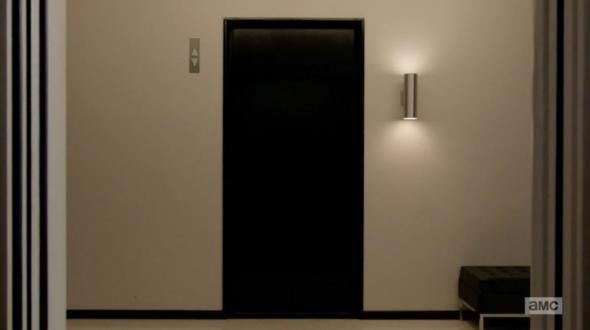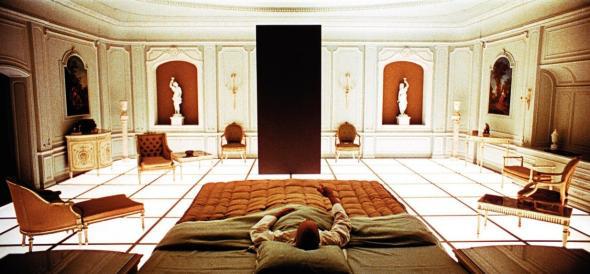Even before last night’s episode of Mad Men aired, some fans suspected it might have Stanley Kubrick on its mind. As Indiewire’s Sam Adams astutely noted a couple weeks back, the episode is called “The Monolith,” bringing to mind the mysterious object that heralds epochal change in 2001: A Space Odyssey. The timing was also ripe for Matthew Weiner to do his own spin on 2001: Kubrick’s “Ultimate Trip” came out in 1968, but it stayed in theaters well into 1969, when “The Monolith” takes place.
The episode “The Monolith” similarly represents potential epochal change in the world of Mad Men, and its allusions to 2001 begin at the very beginning. As soon as Don Draper first appears, getting off the elevator for his first day back at Sterling Cooper, the camera lingers as Don is confronted by this image, reminiscent of the object that gives the episode its title:

Sceengrab by Jeffrey Bloomer for Slate
Don finally learns of the latest sign of this new era when he finds his colleagues: They’re meeting because the company is installing a new computer. As Cutler announces, “This agency has entered the future.”
And it’s not just any computer; it’s an IBM. 2001 is full of allusions to IBM: Even if you don’t buy the theory that the name of 2001’s computer HAL is a coded reference to IBM (just move each letter one forward in the alphabet, theorists say—H to I, A to B, and L to M), 2001 features fictional IBM equipment (you can see IBM’s logo on Dr. Dave Bowman’s suit), and IBM consulted on the movie.
In Mad Men, there’s a not-so-subtle conversation about the potential symbolism of the new computer. Harry Crane insists, “It’s not symbolic.” To which Don responds, “In fact it’s quite literal.”
In some ways this is true, and not just in that the computer has replaced the lunchroom. Both 2001 and “The Monolith” express their themes of fear of technology quite literally. 2001’s central sequence concerns a computer that turns murderous, while in “The Monolith,” Don fears that computers are going to take not only the lunchroom but everyone’s jobs.
From there this man vs. machine confrontation continues. Don represents the primitive man who fears technology. His almost Cro-Magnon status is underlined by a comment from Roger Sterling: “He spent three weeks alone in that cave and hasn’t clubbed another ape yet,” Roger says of Don. This is an allusion to 2001’s “Dawn of Man” sequence, in which Kubrick depicts the first use of tools: The prehistoric humans who learn to use the first weapons prevail, while those who don’t are clubbed to death and left behind.
If Don is our man, then the IBM technician, Lloyd Hawley, represents the machine. He and Don clash three times, with each clash seemingly making its own allusion to 2001. In Hawley’s first appearance, he tells Don and Harry of the computer, “We’ve mastered the infinite,” a possible allusion to the final chapter of 2001, when technology takes man “Beyond the Infinite.”
In Hawley’s next appearance, when he is unable to light a cigarette, Don—once again playing the caveman—taunts him, “you’re unable to make fire.” “The perils of technology,” Don concludes. But Hawley is unfazed, and he counters that it’s just “human error.” This sequence echoes a pivotal exchange in 2001, when the human crew has begun to think that something is wrong with HAL. Defending himself, HAL insists, “It can only be attributable to human error.”
Is Hawley meant to remind us of HAL? It may not be a coincidence that the names of Hawley and Hal bear some resemblance. Don certainly seems to think that Hawley’s not what he seems: “You go by many names,” Don says to him, in their final encounter. “I’m sorry,” Hawley responds, perhaps echoing HAL’s most famous line. It’s not the only apparent 2001 allusion in the scene: Don tells him he’s got “the best campaign since the dawn of time,” once again bringing to mind the Dawn of Man sequence.
I could go on. The episode is full of talk of traveling to the moon: Between Don and Hawley, and between Roger and his daughter. This is appropriate to the period, of course, but the moon is also where modern man next encounters a monolith in 2001. (And the show’s interest in 2001 may extend beyond just this episode: As Sean Howe pointed out on Twitter, Brian Sanders, who was tapped to draw up the poster for Season 6, was also hired by Stanley Kubrick to document Kubrick’s work on 2001.)
So what do all these allusions add up to? First, they serve to reflect history at large in 1969: The dawn of the age of the computer, and man’s trip to the Moon. The significance of the computer, as Don says, is literal, but the allusions to 2001 also make it resonate more widely: The computer represents not just where computers would take an ad agency like Sterling Cooper, but where they would soon take all mankind. In fact, the computer Sterling Cooper gets, the IBM 360, shares its architecture with the computer NASA used to go to space.
And the allusions serve to reflect life for Don at this point in the show. Amid the rapid technological and social change of the ’60s, Don increasingly risks appearing prehistoric—like that ape who still hasn’t learned how to use a club—and being overtaken by someone like Peggy, who is now ordering him around. But he can’t take it out on Peggy, so he focuses his hatred on Hawley. (“It’s been my experience these machines can be a metaphor for whatever’s on people’s minds,” Hawley says earlier in the episode.) Computers haven’t rendered man obsolescent just yet, but if Don doesn’t reinvent himself with the times, he’ll soon go the way of the lunchroom.
